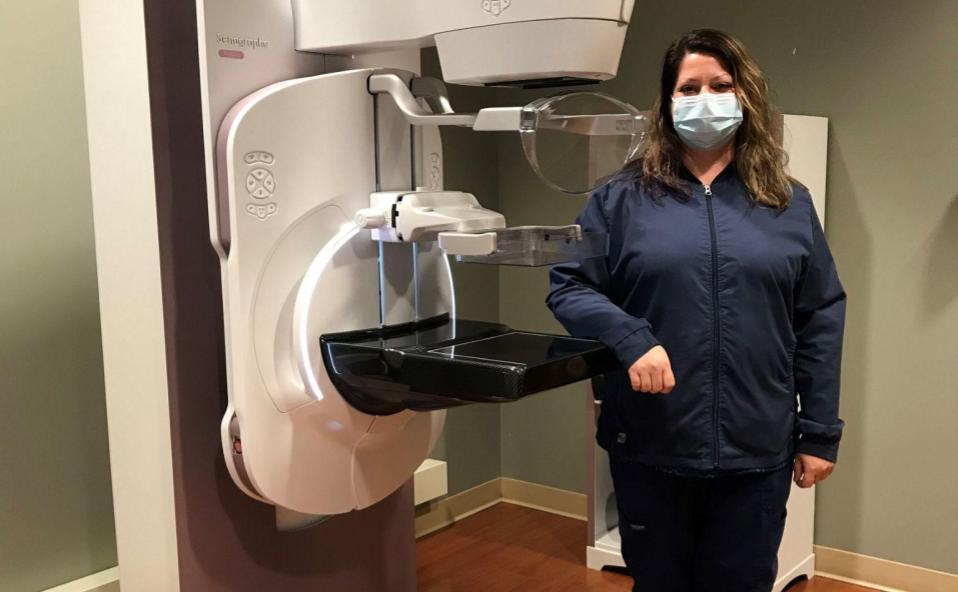 A mammogram is not known for being a relaxing, comfortable or pleasant experience, but it is a necessary annual preventive measure to ensure well-being for all women. UM Shore Regional Health is taking steps to ensure the experience is as comfortable as possible by offering patients a new option in mammograms: The GE Senographe Pristina™ with Dueta. The machine is available at the Diagnostics and Imaging Center at UM Shore Medical Pavilion at Queenstown, 125 Shoreway Drive.
A mammogram is not known for being a relaxing, comfortable or pleasant experience, but it is a necessary annual preventive measure to ensure well-being for all women. UM Shore Regional Health is taking steps to ensure the experience is as comfortable as possible by offering patients a new option in mammograms: The GE Senographe Pristina™ with Dueta. The machine is available at the Diagnostics and Imaging Center at UM Shore Medical Pavilion at Queenstown, 125 Shoreway Drive.
A mammogram screening is appropriate for all at-risk women and any woman over age 40. Using an X-ray to take pictures of the breast, the screening is used to detect the presence of breast cancer in women, even those who have no sign or symptom of the disease. Getting a routine breast exam and mammogram can help detect cancer early, improving the chance it can be treated successfully.
Designed by women and for women, the Senographe Pristina with Dueta, a patient-assisted compression device, offers simplified, more comfortable positioning and compression, and improved image quality. Proper positioning and better image quality can reduce the need for repeat scans. And the patient-assisted compression device puts the patient in control of breast compression, reducing pain and anxiety surrounding mammogram screenings.
Photo: Holly Daly, mammography technologist at UM Shore Medical Pavilion at Queenstown’s Diagnostic and Imaging Center, is pictured with the GE Senographe Pristina™ with Dueta.
“We know the amount of breast compression applied during the mammogram directly influences image quality and radiation dose to the patient,” said Holly Daly, mammography technologist at UM Shore Medical Pavilion at Queenstown’s Diagnostics and Imaging Center. “With the Pristina Dueta remote control device and the assistance of the technologist, patients can now be in control of the finishing compression adjustments, which in turn leads to more comfortable mammograms, clearer mammogram images, less radiation dose to breast tissue, and a reduction of repeat exposures and call-backs.”
Daly said studies with the Pristina Dueta have shown that patients are able to tolerate more breast compression than with previous mammograms and patient satisfaction is improved.
Additionally, with the Senographe Pristina, UM SRH can now bring 3D technology to our patients. This technology, also known as digital breast tomosynthesis, delivers superior diagnostic accuracy at the same low dose as a 2D mammography exam, the lowest patient dose of all FDA-approved 3D mammography systems. The technology uses a low-dose short X-ray “sweep” around the positioned breast with nine exposures acquired with a “step-and-shoot” method. This helps remove any movement of the x-ray tube, reducing blur and increasing image sharpness.
“The exam will be more comfortable and accurate, and the patient can be confident the images will remain high quality, even with their assistance with compression,” Daly said. “I am excited we can now offer this technology to our patients and give them the opportunity to participate in their care.”
For more information about scheduling a mammogram at the Diagnostics and Imaging Center at UM Shore Medical Pavilion at Queenstown, patients should contact their primary care physician or call the UM SRH Central Scheduling line, 410-822-1000, ext. 2600, and ask to schedule a mammogram at that location. Directions and scheduling information is also available by visiting umshoreregional.org.
About University of Maryland Shore Regional Health
As part of the University of Maryland Medical System (UMMS), University of Maryland Shore Regional Health is the principal provider of comprehensive health care services for more than 170,000 residents of Caroline, Dorchester, Kent, Queen Anne’s and Talbot counties on Maryland’s Eastern Shore. UM Shore Regional Health’s team of more than 2,200 employees, medical staff, board members and volunteers works with various community partners to fulfill the organization’s mission of Creating Healthier Communities Together.
About the University of Maryland Medical System
The University of Maryland Medical System (UMMS) is a university-based regional health care system focused on serving the health care needs of Maryland, bringing innovation, discovery and research to the care we provide and educating the state’s future physician and health care professionals through our partnership with the University of Maryland School of Medicine and University of Maryland, Baltimore professional schools (Nursing, Pharmacy, Social Work and Dentistry) in Baltimore. As one of the largest private employers in the State, the health system’s more than 29,500 employees and 4,000 affiliated physicians provide primary and specialty care in more than 150 locations, including 13 hospitals and 9 University of Maryland Urgent Care centers. The UMMS flagship academic campus, the University of Maryland Medical Center in downtown Baltimore, is recognized regionally and nationally for excellence and innovation in specialized care. Our acute care and specialty rehabilitation hospitals serve urban, suburban and rural communities and are located in 13 counties across the State. For more information, visit www.umms.org.


 Created by Donate Life America in 2003, Donate Life Month is observed annually to honor organ donors and their families’ choice to save lives. During the COVID-19 pandemic, The Living Legacy Foundation of Maryland worked with hospitals, transplant centers and healthcare partners to ensure organ transplant safety for recipients and the community. In 2020, over 39,000 lives were saved in the United States. Of these, an all-time high of 33,000 lives were saved were from deceased donors.
Created by Donate Life America in 2003, Donate Life Month is observed annually to honor organ donors and their families’ choice to save lives. During the COVID-19 pandemic, The Living Legacy Foundation of Maryland worked with hospitals, transplant centers and healthcare partners to ensure organ transplant safety for recipients and the community. In 2020, over 39,000 lives were saved in the United States. Of these, an all-time high of 33,000 lives were saved were from deceased donors. “Our vaccine clinics at Chesapeake College and Shore Medical Center at Dorchester are going extremely well, and we’re especially pleased to see more than 150 teens signed up for the Pfizer vaccine,” said UM Shore Regional Health’s regional pharmacy director, Kevin Chapple. “Pfizer is currently the only vaccine approved for 16- and 17-year olds with parental or guardian consent as well as for adults. We’re hopeful that as they get vaccinated, more of their peers will follow suit.”
“Our vaccine clinics at Chesapeake College and Shore Medical Center at Dorchester are going extremely well, and we’re especially pleased to see more than 150 teens signed up for the Pfizer vaccine,” said UM Shore Regional Health’s regional pharmacy director, Kevin Chapple. “Pfizer is currently the only vaccine approved for 16- and 17-year olds with parental or guardian consent as well as for adults. We’re hopeful that as they get vaccinated, more of their peers will follow suit.”



 University of Maryland Shore Regional Health (UM SRH) is operating a new Infusion Center at Shore Medical Center at Easton to provide monoclonal antibody (mAb) treatment for certain individuals with COVID-19.
University of Maryland Shore Regional Health (UM SRH) is operating a new Infusion Center at Shore Medical Center at Easton to provide monoclonal antibody (mAb) treatment for certain individuals with COVID-19. University of Maryland Shore Regional Health’s medical social workers help patients and caregivers during their most vulnerable times through effective communication skills and a holistic approach to patient care needs.
University of Maryland Shore Regional Health’s medical social workers help patients and caregivers during their most vulnerable times through effective communication skills and a holistic approach to patient care needs.